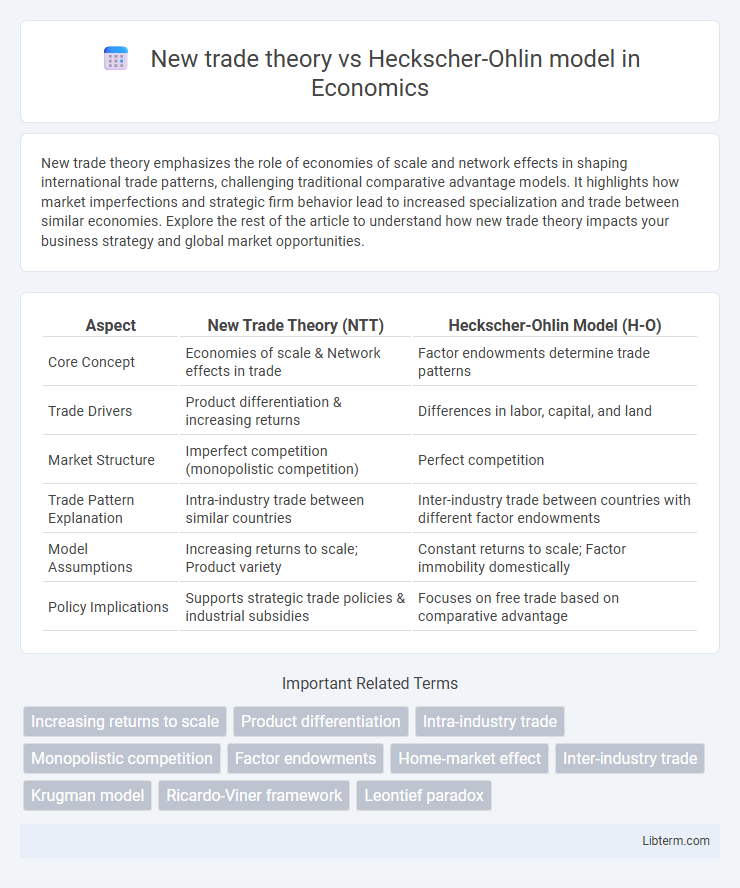New trade theory emphasizes the role of economies of scale and network effects in shaping international trade patterns, challenging traditional comparative advantage models. It highlights how market imperfections and strategic firm behavior lead to increased specialization and trade between similar economies. Explore the rest of the article to understand how new trade theory impacts your business strategy and global market opportunities.
Table of Comparison
| Aspect | New Trade Theory (NTT) | Heckscher-Ohlin Model (H-O) |
|---|---|---|
| Core Concept | Economies of scale & Network effects in trade | Factor endowments determine trade patterns |
| Trade Drivers | Product differentiation & increasing returns | Differences in labor, capital, and land |
| Market Structure | Imperfect competition (monopolistic competition) | Perfect competition |
| Trade Pattern Explanation | Intra-industry trade between similar countries | Inter-industry trade between countries with different factor endowments |
| Model Assumptions | Increasing returns to scale; Product variety | Constant returns to scale; Factor immobility domestically |
| Policy Implications | Supports strategic trade policies & industrial subsidies | Focuses on free trade based on comparative advantage |
Introduction to International Trade Theories
New Trade Theory emphasizes the role of economies of scale and network effects in shaping international trade patterns, contrasting with the Heckscher-Ohlin model which attributes trade to differences in factor endowments such as labor and capital. While the Heckscher-Ohlin model predicts countries export goods that intensively use their abundant factors, New Trade Theory explains trade between similar countries through product differentiation and increasing returns to scale. These theories collectively enhance the understanding of complex global trade dynamics within the framework of International Trade Theories.
Overview of the Heckscher-Ohlin Model
The Heckscher-Ohlin model explains international trade through differences in factor endowments, predicting that countries export goods requiring their abundant factors. It emphasizes capital and labor as key resources, suggesting nations specialize based on relative resource availability rather than technology. This model contrasts with New Trade Theory, which highlights economies of scale and network effects in trade patterns.
Fundamentals of New Trade Theory
New Trade Theory emphasizes economies of scale and network effects as key factors driving international trade, contrasting with the Heckscher-Ohlin model's focus on factor endowments like labor and capital. It explains trade patterns through the presence of increasing returns to scale and product differentiation, which lead to imperfect competition and market power among firms. This theory accounts for intra-industry trade and the role of multinational corporations, highlighting real-world complexities beyond factor proportions.
Key Assumptions: Heckscher-Ohlin vs. New Trade Theory
The Heckscher-Ohlin model assumes countries have different factor endowments, such as labor and capital, which drive comparative advantage and trade patterns. New Trade Theory relies on economies of scale and network effects, emphasizing product differentiation and imperfect competition rather than factor differences. While Heckscher-Ohlin highlights resource-based trade, New Trade Theory explains intra-industry trade and market structure in international trade dynamics.
Role of Comparative and Competitive Advantage
New Trade Theory emphasizes economies of scale and network effects as key drivers of competitive advantage, enabling firms within similar industries to dominate global markets through innovation and product differentiation. The Heckscher-Ohlin model highlights comparative advantage based on factor endowments, such as labor and capital abundance, guiding countries to specialize in goods they can produce most efficiently. Understanding these frameworks helps explain why some nations lead in specialized manufacturing while others benefit from large-scale production efficiencies in global trade dynamics.
Scale Economies and Increasing Returns
New trade theory emphasizes the role of scale economies and increasing returns to explain international trade patterns, highlighting that firms benefit from lower average costs as production expands, which can lead to market concentration and intra-industry trade. In contrast, the Heckscher-Ohlin model relies on factor endowments and assumes constant returns to scale, attributing comparative advantage to differences in labor, capital, and land abundance without considering the impact of economies of scale. Scale economies in new trade theory introduce trade opportunities even between countries with similar resources, challenging the traditional factor-proportions focus of the Heckscher-Ohlin framework.
Product Differentiation and Trade Patterns
New Trade Theory emphasizes the role of product differentiation and economies of scale in shaping trade patterns, explaining intra-industry trade and the existence of similar goods exchanged between countries. The Heckscher-Ohlin model focuses on comparative advantage based on factor endowments, predicting trade patterns driven by differences in labor, capital, and resources rather than product variety. Unlike Heckscher-Ohlin, which assumes homogeneous products, New Trade Theory accounts for consumer preferences for differentiated products, influencing the structure and direction of international trade.
Empirical Evidence and Real-World Applications
Empirical evidence shows that New Trade Theory explains intra-industry trade and economies of scale better than the Heckscher-Ohlin model, which is limited to factor endowments and comparative advantage. Real-world applications highlight New Trade Theory's relevance in industries with high fixed costs and product differentiation, such as automotive and technology sectors. The Heckscher-Ohlin model remains valuable for understanding trade patterns driven by differences in labor, capital, and natural resources across countries.
Policy Implications: Old vs. New Trade Approaches
New trade theory emphasizes economies of scale and network effects, suggesting trade policies that support domestic industries to capture global markets and foster innovation. Heckscher-Ohlin model advocates for policies aligning with factor endowments, promoting specialization based on comparative advantage to enhance efficiency. Governments adopting new trade approaches may implement strategic tariffs and subsidies, contrasting with the old model's focus on free trade and factor price equalization.
Conclusion: Evolving Perspectives on Global Trade
New Trade Theory emphasizes economies of scale and network effects as key drivers of global trade, highlighting the importance of market structure and product differentiation, while the Heckscher-Ohlin model focuses on comparative advantage based on factor endowments like labor and capital. Contemporary trade analysis integrates both frameworks, recognizing that global trade patterns are shaped by a combination of resource distribution and the strategic advantages of scale and innovation. This evolving perspective reflects the complexity of modern international markets and the multifaceted nature of competitive advantage.
New trade theory Infographic

 libterm.com
libterm.com